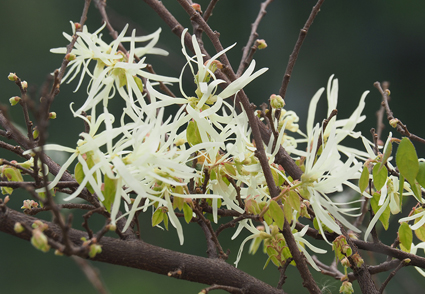Abstract
Loropetalum axillare (Hamamelidaceae), a new species from Zengcheng District, Guangzhou, Guangdong, China, is described and illustrated. The new species is related to Loropetalum chinense but differs by its inflorescence axillary and peduncle absent (vs. inflorescence terminal and peduncle 0.8–1 cm long). The new species is supported by phylogenetic analyses based on ITS and ETS sequences.
References
- Averyanov, L.V., Endress, P.K., Nguyen, K.S., Thai, T.H., Maisak, T.V., Averyanova, A.L. & Diep, L.N. (2018) Loropetalum flavum (Hamamelidaceae), a new species from northern Vietnam. Phytotaxa 385 (2): 94–100.
- Bentham, G. (1861) Flora Hongkongensis. L. Reeve, London, 482 pp.
- Brown, R. (1818) Narrative of a Journey in the Interior of China. Printed for Longman, Hurst, Rees, Orme, and Brown, London. 420 pp.
- Guindon, S., Dufayard, J.F., Lefort, V., Anisimova, M., Hordijk, W. & Gascuel, O. (2010) New algorithms and methods to estimate maximum-likelihood phylogenies: assessing the performance of PhyML 3.0. Systematic Biology 59: 307–321. https://doi.org/10.1093/sysbio/syq010
- Hall, T.A. (1999) BioEdit: A user-friendly biological sequence alignment program for Windows 95/98/NT. Nucleic Acids Symposium Series 41: 95–98.
- Handel-Mazzetti, H.R.E. (1932) Plantae Novae Chingianae. Pars II. Sinensia 2 (10): 123–132.
- Katoh, K. & Standley, D.M. (2013) MAffT multiple sequence alignment software version 7: improvements in performance and usability. Molecular Biology and Evolution 30: 772–780. https://doi.org/10.1093/molbev/mst010
- Linnaeus, C. (1753) Species plantarum, vol. 1. Laurentius Salvius, Stockholm, 560 pp.
- Minh, B.Q., Nguyen, M.A. & Haeseler, A. (2013) Ultrafast approximation for phylogenetic bootstrap. Molecular Biology and Evolution 30: 1188–1195. https://doi.org/10.1093/molbev/mst024
- Nguyen, L.T., Schmidt, H.A., Haeseler, A. & Minh, B.Q. (2015) IQ-TREE: a fast and effective stochastic algorithm for estimating maximum-likelihood phylogenies. Molecular Biology and Evolution 32: 268–274. https://doi.org/10.1093/molbev/msu300
- Oliver, D. (1862) Note on Hamamelis and Loropetalum, with a description of a new Anisophyllea from Malacca. Transactions of the Linnean Society of London 23: 457–461. https://doi.org/10.1111/j.1096-3642.1860.tb00143.x
- Oliver, D. (1883) Loropetalum subcordatum (Benth.) Oliver. In: Hooker, W.J. & Hooker, J.D. (Eds.) Hooker’s Icones Plantarum. Vol. 15. Part. 1. Longman et al., London, pp. 13–14.
- Reichenbach, H.G.L. (1828–1829) Conspectus Regni Vegetabilis Per Gradus Naturales Evoluti. Carolus Cnobloch, Leipzig, 294 pp.
- Ronquist, F. & Huelsenbeck, J.P. (2003) Mrbayes 3: Bayesian phylogenetic inference under mixed models. Bioinformatics 19: 1572–1574. https://doi.org/10.1093/bioinformatics/btg180
- Xie, L., Yi, T.S., Li, R., Li, D.Z. & Wen, J. (2010) Evolution and biogeographic diversification of the witch-hazel genus (Hamamelis L., Hamamelidaceae) in the Northern Hemisphere. Molecular Phylogenetics Evolution 56 (2): 675–89.
- Zhang, D., Gao, F., Jakovlić, I., Zou, H., Zhang, J., Li, W.X. & Wang, G.T. (2019) PhyloSuite: an integrated and scalable desktop platform for streamlined molecular sequence data management and evolutionary phylogenetics studies. Molecular Ecology Resources 20: 348–355.
- Zhang, Z., Zhang, H. & Endress, P.K. (2003) Hamamelidaceae. In: Wu, Z.Y. & Raven, P.H. (Eds.) Flora of China. Vol. 9. Science Press, Beijing, and Missouri Botanical Garden, St. Louis, 496 pp.


